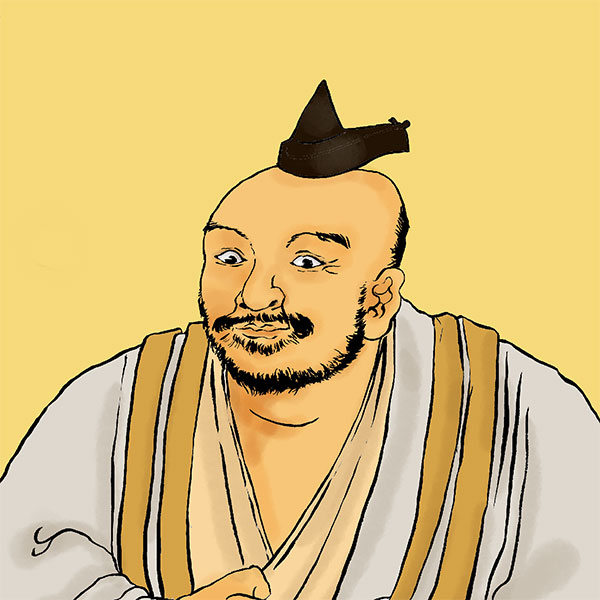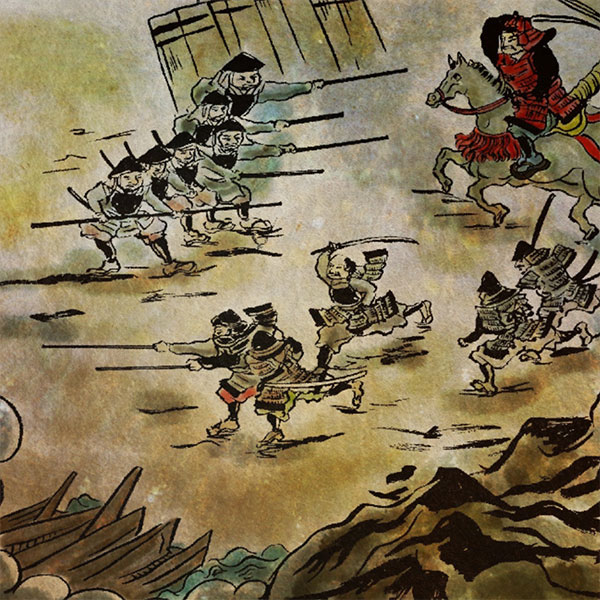Takanobu Ryuzoji (2/2)The man called Hizen no Kuma

Takanobu Ryuzoji
- Article category
- biography
- name
- Ryuzoji Takanobu (1529-1584)
- place of birth
- Saga Prefecture
- Related castles

Saga Castle
- related incident
After that, he worked hard to expand his power, and in 1559, he attacked the Shoni clan, which was his former master, and forced Fuyuhisa Shoni to commit suicide at Sefukuji Castle, completely destroying the Shoni clan as a daimyo. I did.
In addition, he conquered Hizen clansmen such as the Egami clan and the Inuzuka clan one after another, and in 1560 he attacked and destroyed Chiba Tsuneyori.
Furthermore, the Shoni clan's former vassals, such as the Baba clan and the Yokogaku clan, were defeated, and in 1561, they defeated Jindai Victory at the Battle of Kawakami Gorge, and by 1562, they established control over Higashi-Hizen. did.
The rapid expansion of power shocked neighboring feudal lords such as the Arima clan and the Omura clan, and in 1563 the two clans united to invade Higashi Hizen, but Takanobu formed an alliance with the Chiba Tanedren. This allied force was defeated (Battle of Tanzaka Pass). As his influence extended to southern Hizen, Sorin Otomo of Bungo Province saw Takanobu as dangerous and supported Masaoki Shoni, the surviving member of the Shoni clan. Former vassals of the Shoni clan, such as the Baba clan and the Yokotake clan, joined in to oppose Takanobu.
In 1569, Sorin himself led a large army to invade Hizen, but Motonari Mori invaded Buzen Province, so Sorin withdrew from Hizen (Battle of Tabuseguchi).
Afterwards, Sorin defeated Motonari and organized an army of 3,000 men with his younger brother Chikasada Otomo as the commander-in-chief in the first year of Genki (1570) and invaded Hizen. However, Takanobu repulsed this attack through a surprise attack by Nobuo Nabeshima (later Nabeshima Naoshige).
Afterwards, he concluded a favorable peace with the Otomo clan, but although Takanobu won the Battle of Imayama, it was a local victory. At this point, the Otomo clan's control over Hizen cannot be ruled out.
Even after the Battle of Imayama, the Otomo clan sent word of military mobilization to Takanobu, and his son and politician received the nickname (the character for ``chin'') from Sorin Otomo (Yoshishige), and for a time he was known as ``Chinken'' (the character for ``chin''). His name is Shigetomo). Every time Takanobu destroyed or subjugated the people of the surrounding country, a messenger came from Sorin to question him.
In the end, the territory they had carved out was recognized as a vested interest, and by the time of the Battle of Mimikawa, they steadily expanded their territory and accumulated power.
In 1572, Shoni Masaoki was expelled from Hizen. In 1573, he conquered Western Hizen, and in 1575, he conquered Higashi Hizen. In the 4th year of Tensho (1576), he invaded Minami Hizen, and by the 5th year of Tensho (1577), he had subdued Sumitada Omura, and in the 6th year of Tensho (1578), he had taken down Matsuoka Castle of Arima Chizumi and unified Hizen. completed. In April 1580, he handed over the headship of the family to his eldest son, Masaie, and retired to Suko Castle. Even after his retirement, he continued to hold real political and military power.
Expansion of power and end
In 1578, when Sorin Otomo was defeated by Yoshihisa Shimazu at the Battle of Mimikawa, Takanobu took advantage of the confusion in the Otomo clan and swept over the territory of the Otomo clan, achieving complete independence from the Otomo clan and achieving complete independence from the Otomo clan. Subjugate the people who were related to it.
By 1580, they had succeeded in bringing Chikuzen Province, Chikugo Province, Higo Province, and Buzen Province under their control. However, in the 8th year of Tensho (1580), he murdered Chinren Kamachi in Chikugo, who was colluding with Shimazu, and then killed Chinren's entire family in Yanagawa. Furthermore, when Toie Akahoshi disobeyed Takanobu's orders in 1583, he killed Akahoshi's young son and daughter who were kept as hostages, which gave Takanobu the impression that he was cruel even to some of his subordinate generals. You will be able to see it.
In March 1584, Arima Harunobu defected from the Ryuzoji clan. Harunobu's relatives Junji Yasutomi, the lord of Fukae Castle in the same area, and Sumiyasu father and son were still on the Ryuzoji side, but Arima Harunobu attacked Fukae Castle and Shimazu joined in, so Takanobu set out to rescue Fukae Castle and defeat Arima. I sent an army.
However, the attack on Arima was slow to progress, and Takanobu, frustrated, decided to lead a large army himself and engage in a decisive battle against the combined forces of Shimazu and Arima. The Ryuzoji army was a large army of 25,000 men, while the Shimazu army was only less than 10,000, which was an overwhelming difference in strength. He was defeated by a pincer attack from the Hisa army and the Arima army. The Ryuzoji side lost many soldiers and their general, Takanobu, was killed by Tadakata Kawakami, a vassal of the Shimazu clan. Passed away at age 56. His Buddhist name is Souryu Taigan, Hounin. Nabeshima Naoshige, a senior vassal, attempted to commit suicide upon hearing of Takanobu's death, but was stopped by his vassals and retreated to Yanagawa. It is said that after Takanobu's head, which was captured by the Shimazu army, was examined by Iehisa Shimazu, the Ryuzoji family refused to accept it and was buried at Gangyo-ji Temple (Tamana City).
Saga Castle
Saga Ryuzoji Castle is the residence of the Ryuzoji head family for generations, and it took on its current appearance through renovations by the Nabeshima clan during the Keicho period of the Edo period. The ancient name is Saka Castle, and other names are Sunken Castle and Turtle Castle.
After it was completed in the early Edo period, it became the residence of the Tozama daimyo Nabeshima clan of the Saga domain.
The castle appears to be sinking into the trees, and it used to have multiple outer moats, and in the event of an attack, a large amount of water was pumped in from the Tabuse River to submerge everything except the main castle, defending it from enemy invasion. It has a history of being called a "sunken castle" because of the fact that it was
Most of the buildings were burnt down during the Saga Rebellion that occurred in the early Meiji period, with only the Shachi-no-mon Gate and Tsuzuki Yagura remaining, designated as important cultural properties of the country. Recent research suggests that the castle tower that was destroyed by fire in 1995 was on par with Kokura Castle, or slightly larger.
Currently, the castle ruins are being maintained as Saga Castle Park, the Honmaru Palace has been restored as a wooden structure and is open to the public as the Saga Prefectural Saga Castle Honmaru History Museum, and the surrounding area has been restored to its eastern moat and earthworks, and is beginning to regain its former appearance. Ninomaru is the political and economic center of Saga Prefecture, with public facilities such as the Saga Prefectural Office, joint government building, broadcasting station, art museum, museum, and elementary, middle, and high school schools.
Ryuzoji Temple Takanobu Festival
One of Saga City's historic sites, Akashido, located on Inui-michi, Kawazoe Town, was built in 1553 by Lord Ryuzoji Takanobu, who was chased by his vassals and escaped from Chikugo, leading local residents to retake Saka Castle. A seated statue of Takanobu was erected by local residents at the place where he landed.
Local people hold the "Ryuzoji Takanobu Festival" in front of the statue of Ryuzoji Takanobu. The festival has a deep connection with the story that in 1553, Lord Takanobu, who was planning to recapture Mizugae Castle, landed in this area, and the power of Kawazoe Town had a big role in his later successes, so it is still important today. It has been.
Ryuzoji Takanobu and net fishing
In the 20th year of Tenbun (1551), Mizugae Castle was besieged by vassals secretly informed by Sorin Otomo in Bungo, and Ryuzoji Takanobu (1529-1584) fled to Ichiki Village near Yanagawa in Chikugo, relying on Kamimori Kamachi, the lord of Yanagawa Castle. I secluded myself.
In 1553, Takanobu, who was secretly plotting to recapture Mizugae Castle, boarded a boat run by Kaneaki Kae and landed at Todo at the end of Inui Road. At that time, this area was still a coast full of reeds and was called Todo because there was a hall where lights were lit to pray for safe passage.
At this time, the pilots were fishermen Jirobe Sonoda and Shinbei Inui Michi, and both of them were given ``certificates'' that allowed them to use vertical fishing nets and hajisashi nets (set nets), which are the current fishing rights. it was done. This Hanmono wooden tag was written in 1605 when Takanobu's younger brother Naganobu's son Yohei (Anjun, the second head of Taku) granted Sonoda and Inui the same privileges as before (Hajisashiami). , he was ordered to pay 100 yen of fish to the domain.
This fishing right continues to be protected by their descendants. The seated statue of Takanobu in the Todo Hall was erected in April 1951 by his descendants and other volunteers. Afterwards, Takanobu entered Itokuji Temple in Shikae, raised his flag with the help of more than 3,000 samurai from Kawazoe and Yogago, and for the next 30 years attacked surrounding military commanders with unparalleled vigor, conquering the Gokoku and Two Islands. He became a great feudal lord and built up one of the great feudal domains in Kyushu, along with Shimazu in Satsuma and Otomo in Bungo.
Itoku-ji Temple has as temple treasures an ``image'' of Lord Takanobu's dharma body and a ``jindaiko'' said to have been used by Lord Takanobu. It is said that the Konoka Daimyojin Shrine in Kokomori placed military supplies here when it prepared its military at Itokuji Temple. The military flag used by Takanobu remains at Shiga Shrine in Hayatsue.
Also in the town are Kaido Shrine (Inuido), Tenmangu Shrine (Kanbun), Tenman Shrine (Anae), Tenmangu Shrine (Funatsu), Tenman Shrine (Shigehisa), Tenmangu Shrine (Komori), Kaido Shrine (Hiroe). There are also many shrines related to Takanobu, such as Tenman-sha (Hisumachi) and Tenman-sha (Shinmura).
Reread the article by Takanobu Ryuzoji
- related incident

- WriterTomoyo Hazuki(Writer)I have loved history and geography since my student days, and have enjoyed visiting historical sites, temples and shrines, and researching ancient documents. He is especially strong in medieval Japanese history and European history in world history, and has read a wide range of things, including primary sources and historical entertainment novels. There are so many favorite military commanders and castles that I can't name them, but I especially like Hisashi Matsunaga and Mitsuhide Akechi, and when it comes to castles, I like Hikone Castle and Fushimi Castle. Once you start talking about the lives of warlords and the history of castles, there's a side of you that can't stop talking about them.




